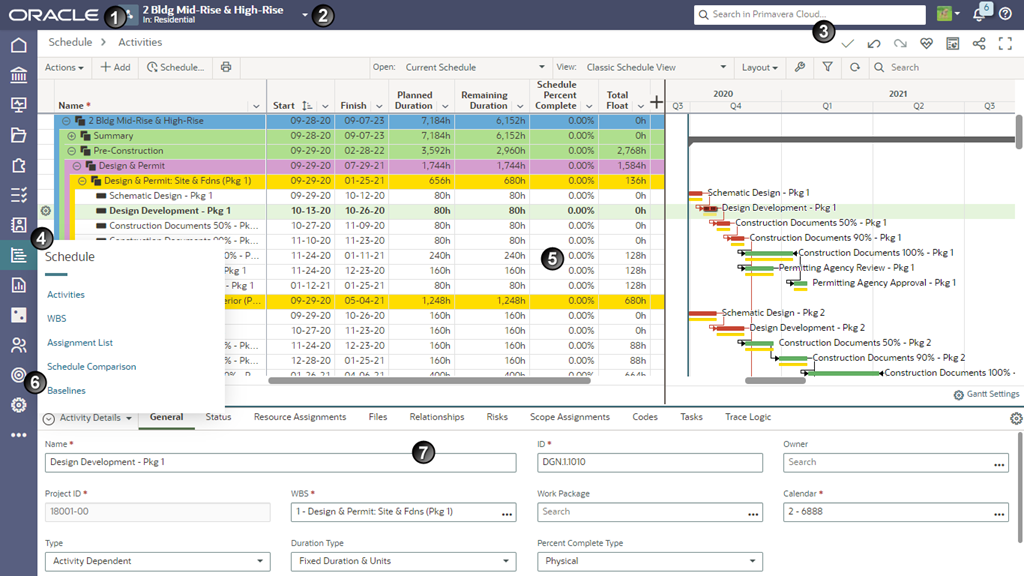The Primavera Cloud User Interface
Although the location of objects and settings may differ from P6, they can still be easily found in Primavera Cloud. Consult the screenshot and table below for a general layout of the application and its most common features.
Select an object to open using the Object Selector at the top of the page. Each object type has its own set of apps, which group pages with similar functionality together. For example, the Schedule app can be found in the context of a project or program. Access apps, pages, and Summary & Settings using the Main Menu. You can control which apps users can access by configuring app presets. Administrators have additional access to the Global Admin app to configure companies, users, and application-wide settings.

Table of Screen Highlights
Item | Description |
|---|---|
1 | Get Started: The Get Started page is every user's first view of Primavera Cloud. Select the Oracle logo from anywhere in the application to open it. You can watch a video about how the application works, get started by creating or accessing projects, and access additional resources such as the Help and the Training Center. |
2 | Object Selector: Use the object selector to open an object or access the inventory of all objects in the application. This can be projects, portfolios, programs, workspaces, or ideas. Only one object can be open at a time in a single browser tab, but you can have multiple objects open simultaneously by opening objects in different browser tabs or windows. Available objects are determined by a user's level of access. Users with the proper privileges can also use the Global Admin app to configure application-wide and administrative-level settings. You can also use the object selector to add new objects and access your recent and favorite objects. |
3 | Use the icons in the header of the application window to access a global search, the User menu, the View notifications panel, and the Help. Below the header are common icons that control functionality on the page. This includes save, undo and redo, run reports, and share. |
4 | Main Menu and Page Selector: The Main Menu contains links to apps dependent on the object context you are in such as a workspace, portfolio, or project. The order and number of apps displayed in the Main Menu can be customized per user. Select an app to display its pages. Select a page to open it in the main window. Show or Hide apps using the Edit Menu. |
5 | Main Window: This is where page-level actions are performed and where the most important page data is displayed. Depending on the page, the main window might show a table, Gantt chart, settings, graphic chart, planning board, or activity network. Pages can also contain toolbars, detail windows, and side panels. |
6 | Summary & Settings: Select the gear icon in the Main Menu to view the Summary & Settings page for the current object. This panel enables you to configure general settings, defaults, dictionaries, and security for the object, as well as settings for the object's parent workspace. |
7 | Detail Windows: Detail windows provide additional information about the objects selected in the main window. Some have corresponding pages that contain the same information. You can also use detail windows to establish initial object data. |
Last Published Friday, December 19, 2025